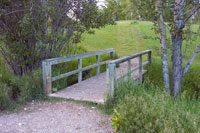12 Mile Coulee
Location: Tuscany Blvd N.W. & Stoney Trail N.W.
Area: 190 hectares

Twelve-mile Coulee Park is in the extreme northwest corner of the city and was established in 2001. The coulee and nearby road were originally named because they were about 12 miles from the post office in Fort Calgary and served as a mail drop on the old stagecoach run to Cochrane.
Park Features
- Hiking trails
- Park benches
Experience Nature in the City
In this park you can visit a classic prairie coulee. A coulee is the regional term for a small valley or gully. The term originated with the Metis, who used the French verb "couler," meaning "to flow," to describe this land-form where seasonal water flows from snow-melt or heavy rains. As in most coulees, there is a mix of grassland, shrubs and trees which play an important role in the prairie ecosystem.
Plant Life
Southern exposures of the coulee are the driest and are primarily native grassland consisting of Rough Fescue, Perry Oatgrass and spear grasses. Intermixed with the grasses are wild flowers including Prairie Crocus and Golden Bean. On the moister northern exposures and shaded areas one finds shrubs like willows, Red-osier Dogwoods and American Silverberry as well as trees such as Trembling Aspen, Balsam Poplar and White Spruce.
Wildlife
The grasslands and tree/shrub communities in prairie coulees are home to many species of animals which, with a little luck, you can still find in Twelve-mile Coulee. Look for Richardson's Ground Squirrels (often incorrectly called gophers) and the mounds of Northern Pocket Gophers (which are true gophers). Watch also for deer, coyotes, porcupines and even the odd Red Fox.
Overhead, you may see circling raptors including Swainson's Hawks and Northern Harriers. In the trees there are nuthatches, woodpeckers and several species of warblers and vireos, and in the grasslands look for native sparrows.
History
The dominant land form is the coulee itself, which slopes southerly toward the Bow River. Along the eastern slope there are sandstone outcrops which are part of the "Porcupine Hills Formation" of bedrock that underlies the entire city. Toward the south end of the coulee, a large outcropping of bedrock is one of the best and most accessible examples of this formation in the city.
Archaeological artefacts, including a 2000 year-old stone circle or tipi ring, indicate that Aboriginal people had been using the park area for hunting and camping for at least 8000 years. Since the 1800's, European settlers used the area for farming and ranching.